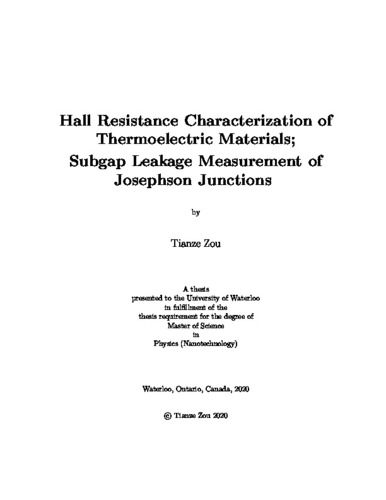| dc.contributor.author | Zou, Tianze | |
| dc.date.accessioned | 2020-06-01 19:56:04 (GMT) | |
| dc.date.available | 2020-06-01 19:56:04 (GMT) | |
| dc.date.issued | 2020-06-01 | |
| dc.date.submitted | 2020-05-31 | |
| dc.identifier.uri | http://hdl.handle.net/10012/15973 | |
| dc.description.abstract | The thesis has two parts. The first part is the Hall measurement of thermoelectric materials which are promising energy sources in the future. By characterizing the Hall resistance at different environments, their charge carrier density and mobility can be calculated, which is important to explain their unique electrical and thermal properties at different temperatures. However, due to the geometry of the samples, the strong thermoelectric properties of the materials, and some electrical noise sources of the experimental setup, the measurement uncertainty is questionable.
In this thesis, a DC Hall measurement setup and an AC Hall measurement setup are built which are designed for the electrical conductivity measurement and the Hall resistance measurement of bulky bar samples made of thermoelectric materials. The measurement uncertainty caused by different noise sources are characterized and then compared with the theoretical predictions. The conclusion is that both setups have their unique advantages and limitations. It is found that the AC method has higher measurement speed than the DC method. The usage of a low-noise transformer in the AC Hall measurement and the PI temperature control system can reduce the measurement uncertainty.
The second part of the thesis is about the subgap leakage measurement of Nb/AlOx/Nb Josephson junctions which are important in the applications of quantum computing. The subgap leakage current at low temperature is caused by the intrinsic defects of the junctions, which limits their behaviour. Therefore, the superconducting properties of the junctions at low temperatures need to be characterized by the subgap leakage measurement.
In this thesis, the junctions are mounted in a dry adiabatic demagnetization refrigerator (ADR) and cooled down to as low as 130 $mK$. A voltage-bias circuit and a current-bias circuit for the measurement are designed and used. A NbTi superconducting magnet is made to provide magnetic fields to suppress the supercurrent of the junctions. The I-V curves of some junctions are measured which show the information of their subgap regions, the temperature dependence of their subgap leakage currents and their response to the magnetic field. The conclusion is that the subgap leakage measurement can be done with this low-temperature measurement setup. Details of the design are described in this thesis. | en |
| dc.language.iso | en | en |
| dc.publisher | University of Waterloo | en |
| dc.subject | Hall measurement | en |
| dc.subject | subgap leakage measurement | en |
| dc.subject | Josephson junctions | en |
| dc.title | Hall Resistance Characterization of Thermoelectric Materials; Subgap Leakage Measurement of Josephson Junctions | en |
| dc.type | Master Thesis | en |
| dc.pending | false | |
| uws-etd.degree.department | Physics and Astronomy | en |
| uws-etd.degree.discipline | Physics (Nanotechnology) | en |
| uws-etd.degree.grantor | University of Waterloo | en |
| uws-etd.degree | Master of Science | en |
| uws.contributor.advisor | Kycia, Jan | |
| uws.contributor.affiliation1 | Faculty of Science | en |
| uws.published.city | Waterloo | en |
| uws.published.country | Canada | en |
| uws.published.province | Ontario | en |
| uws.typeOfResource | Text | en |
| uws.peerReviewStatus | Unreviewed | en |
| uws.scholarLevel | Graduate | en |

